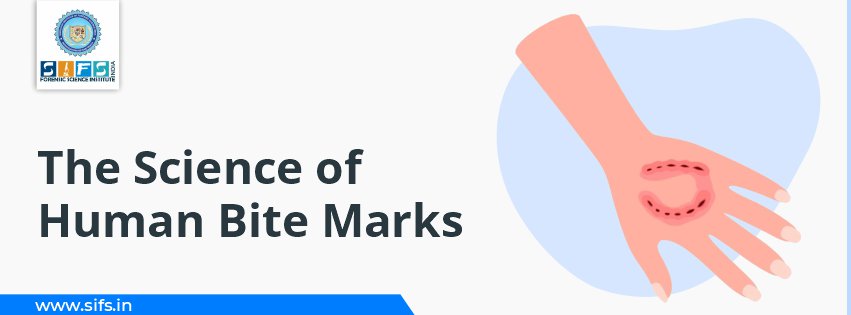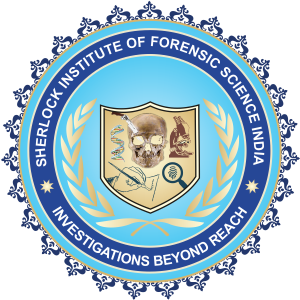- Call Us: +91 7303913002
- Email Us: education@sifs.in
The Science of Human Bite Marks

BY SIFS India | January 24, 2025
The Science of Human Bite Marks
Recently there is a progressive change in the social, economical, educational and developmental technologies in the world.
Due to these newer advances, man is getting more and more selfish in his desires and demands. This advent of new thinking of human beings in all areas has led to exceptions in crime occurrence.
In the criminal justice system where no two individuals can have identical teeth there, forensic odontology has gained a wider acceptance.
Bite marks are one of the indispensable pieces of physical evidence in rape cases, murder cases and violence like acts.
Bite marks are defined as the marks that occurred due to the result of either physical alteration in a medium caused by the contact of the teeth or a representative pattern left in an object or tissue by the dental structures of an animal or human being.
These marks are expressions of anger, dominating nature of animalistic behaviour.
These are considered as one of the commest forms of dental evidence presented in any court trial in rape cases.
They are valuable sources to predict the type of physical abuse and age bracket of the criminal.
Dealing bite marks evidence there is a role of a forensic dentist who helps in the exclusion of a suspect in rape cases based on their tooth pattern and opening ranges.
With increasing the lapse of criminal cases like rape, human bite marks are valuable forensic odontological evidence for nailing culprits.
These bite marks carry a high forensic value based on the characteristics of bite marks which are similar to the culprit. Physical evidence such as bite marks is conclusive as DNA and fingerprint evidence in rape cases.
Therefore it can be rightly concluded that “Criminals may lie through their teeth, but his/her bite marks will reveal all and never lie"
What is a Bite Mark?
It is a mark generated by the teeth alone or in combination with other mouthparts as defined by McDonald.
They are tool marks left by the action of teeth and oral structure during the biting process of foods, objects and individuals.
These marks are usually found on a living or dead person where the identity of the individual has to be revealed with respect to the victim in a crime or a perpetrator of the crime.
History of Bite Marks
These marks came into the highlight in the 1870s but the pioneer Sorup publish its finding as an “Analysis of bite marks” in 1924. During his investigation, he used a transparent paper presentation of a suspected person's dentition and compared it with a life-size bite mark photograph. Many cases have been reported of bite marks and due to this analysis has been improved with accurate and advanced techniques to match, evaluate and present bite marks.
Types of Bite Marks Injuries
There are various types of bite marks injuries which can be classified by four types of impression:
Contusion: Ruptured blood vessel, bruise
Laceration: Punctured or torn skin
Incision: Near puncture of skin
Avulsion: Removal of skin
Identification of Bite Marks
Physical characteristics for matching the suspect teeth with bite marks include:
- The distance between cuspid to cuspid
- The shape of the arch
- Width, thickness and spacing between the teeth
- Missing teeth
- The curves of biting edges
- Wear patterns
As we know, human skin is a poor medium for bite marks registration.
The appearance of these marks is influenced both by the mechanism and forces which lead to their impression and even by the mechanical properties of the skin, subcutaneous tissue or other bitten material.
So, there are many factors affecting the appearance of the bite marks which includes:
- Location of bite on the body
- Clothing
- Curvature of the bitten surface which depends upon the dragging during bitting process; structure &vascularity of tissue, medication, and environmental factors.
- Directional variation due to the role of langer lines which are being followed during flexion, extension and rotation of surface skin markings.
Methods to Preserve Bite Marks Evidence
Bite Mark Casting
It should be taken according to the American Board of Forensic odontology(ABFO) guidelines. Dental stone, acrylic or plaster of Paris can be used as supporting material for the impression which will record an accurate report of the curvature of skins.
Tape Lifting/Powder Method
It is similar to the method used for lifting fingerprints from crime scenes such as fingerprint lifting tape can be used to lift the non-perforating bite marks after brushing the bite mark with fingerprint lifting powder. Excellent clarity and detail are obtained with this method.
Swabbing for Saliva
In this technique, Saliva of the bite site should be obtained whenever possible. Swabbings are done to collect DNA present in salivary trace evidence.
The double swab technique involves swabbing the bitemark site with saline moistened sterile cotton swab, then removing the moisture with a second dry swab and both swabs are sent for analysis.
Research has shown recovery of the biter’s exfoliated epithelial cells from salivary trace evidence.
Photographic Documentation
The most common method used to document and preserve bite mark evidence is through the use of photography.
The bite site should be photographed using conventional photography and followed the guidelines as described in the ABFO bite mark analysis guidelines. Close up photographs of the bite mark should be taken with ABFO scale No.2 and with a photographic scale.
Experienced photographers using both colour transparency and black and white film with a negative size of 35mm or larger should take photographs.
Lighting, camera orientation, close-up capability and stability are extremely critical. In addition to visible light photographic documentation, ultraviolet photography and digital photography can be used to record the bite mark injury.
Videotape Documentation
The videotape documentation demonstrated a three-dimensionally of the bite in motion.
The video equipment should be selected on the basis of four criteria like its portability, the quality of the image produced, its ease of use by untrained personnel and the intended use of the final image.
This equipment can range from essential equipment such as lights and tripods to convenience equipment as simple as extension cords; playback units and editing facilities.
Radiographic Documentation
Bite marks can also be interpreted through soft tissue radiography. It has the advantage of penetrating the tissue thereby revealing damage that might not be observed in the photographic approach.
Xeroradiography and contrast-enhanced radiography can add valuable information and should be considered as an adjunct to standard photographic procedures.
These documentation methods have to be compared with that of the suspect’s teeth.
The most common method to determine if the suspect’s teeth caused the bite mark includes techniques to compare the pattern of the teeth with similar traits and characteristics present in life-sized photographs of the injury using transparent overlays.
Overlays can be produced using various techniques.
The most accurate technique has been found to be a method using a computer.
Other comparison methods include the direct comparison of the suspect’s study cast with photographs of the bite mark, comparison of test bites produced from the suspect's teeth with the actual bite marks of the individual and the use of radiographic imaging and scanning microscopy.
Conclusion
The science behind the human bite marks analysis is relatively new and potentially valuable. these types of analysis have been instrumental in the criminal investigation of homicide, sexual assault and abuses cases.
Human dentition plays a significant role in resolving above mentioned cases and it is influenced by genetic factors and environmental factors for determining the position of teeth in the arch.
There is no such database to express quantitatively the uniqueness of human dentition. It can be concluded that more research should be shine and investigated in the area of bite marks accuracy and reliability in Forensic dentistry.

